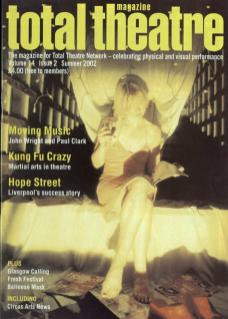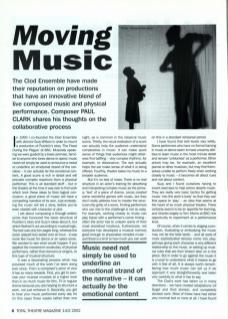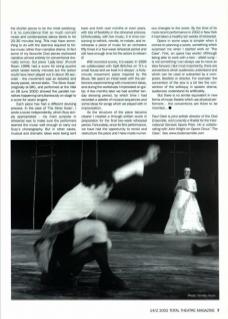In 1995 I co-founded the Clod Ensemble with director Suzy Willson in order to mount a production of Pushkin's story 'The Feast During the Plague' at BAC. Musically speaking we were guided by a basic premise, familiar to anyone who loves dance or opera: music need not simply be used to announce a mood or underline an emotional strand of the narrative – it can actually be the emotional content. A good score is rich in detail and will provoke complex reactions from a physical performer. This is all standard stuff – but in the theatre at the time it was rare to find work which took these ideas to their logical conclusion: a good piece of music will have a compelling narrative of its own. Just embodying the music will tell a story, before you've even started with character or plot.
I set about composing a through-written score that honoured the basic structure of Pushkin's story and Suzy's ideas about it, but which fleshed it out according to musical logic. The text was only ten pages long, whereas the score (played live) lasted over an hour – it was more like music for dance or an opera score. We wanted to see what would happen if you applied the movement vocabulary of physical performers, rather than dancers or singers, to this type of musical structure.
It was a fascinating process which has provoked much of the work I've been doing ever since. From a composer's point of view it has so many rewards. First, you get to exercise your musical muscles at a higher level than in so much music for film, TV or regular drama because you are helping to structure a work, not just enhance it. Secondly, you get to hear your music performed every day for (in this case) three weeks rather than one night, as is common in the classical music scene. Thirdly, the visual realisation of a score can actually help the audience understand complexities in music. It can make quick sense of things that audiences might otherwise find baffling – very complex rhythms, for example, or dissonance. The eye actually helps the ear make sense of what it is being offered. Fourthly, theatre takes my music to a broader audience.
But it's no bed of roses. There is no real structure in an actor's training for absorbing and interpreting complex music as the primary 'text' of a piece of drama. Lecoq created some wonderful games with music, but they don't really address how to master the structural nitty gritty of a score. Finding performers who can rise to the challenge is not so easy. For example, working closely to music can play havoc with a performer's comic timing – often the actor has to unlearn some of their most cherished intuitions. Furthermore, not everyone has developed a musical memory good enough to physicalise complex music – and there is a limit to how much you can work on this in a standard rehearsal period.
I have found that skill levels vary wildly. Some performers who have no formal training in music or dance seem to have uncanny abilities to learn music in the most minute detail and remain 'unblocked' as a performer. Other actors may be, for example, an excellent pianist or other musician, but may find themselves unable to perform freely when working closely to music – it becomes all about cues and not about content.
Suzy and I found ourselves having to invent exercises to help actors absorb music. They are really very basic tactics for getting music into the actor's ‘body' so that they can find space to ‘play’ – an idea that seems at the heart of so much physical theatre. There certainly seems to be an appetite for learning and (thanks largely to Tom Morris at BAC) the opportunity to experiment at a performance level.
Of course, when it comes to staging a production, illustrating or embodying the music may not be the best tactic – and all sorts of more sophisticated devices come into play: perhaps giving each character a very different relationship to the music, or setting up musical rules that are then broken later on in the piece. But in order to go against the music it is crucial to understand what it means to go with it first of all. It is always worth remembering how much music can tell us if we approach it very straightforwardly and listen very carefully to what it has to say.
Music need not simply be used to underline an emotional strand of the narrative – it can actually be the emotional content
The Clod's work has taken us in many directions – we have created adaptations (of Gogol and Ovid stories), and completely devised work. Most of these have had either very minimal text or none at all. I have found the shorter pieces to be the most satisfying: it is no coincidence that so much concert music and contemporary dance tends to be 20-30 minutes long. This may have something to do with the stamina required to follow music rather than narrative drama. In fact some of my favourite Clod pieces eschewed narrative almost entirely (in conventional dramatic terms). Our piece Lady Grey (Purcell Room 1999) had a score for string quartet which lasted twenty minutes but the action could have been played out in about 30 seconds – the movement was so detailed and slowly paced, almost static. The Silver Swan (originally at BAC, and performed at the V&A on 28 June 2002) showed five parallel narratives happening simultaneously on stage to a score for seven singers.
Each piece has had a different devising process. In the case of The Silver Swan, I wrote a score independently, which Suzy simply appropriated – my main purpose in rehearsal was to make sure the performers learned the music well enough to carry out Suzy's choreography. But in other cases, musical and dramatic ideas were being sent back and forth over months or even years, with lots of flexibility in the rehearsal process. Unfortunately, with live music, it is time-consuming to rethink, rewrite, re-notate, and re-rehearse a piece of music for an orchestra fifty times in a four-week rehearsal period and still have enough time for the actors to relearn.
With recorded scores, it is easier. In 1999 we collaborated with Split Britches on It's a small house and we lived in it always, a forty-minute movement piece inspired by the Blues. We spent an initial week with the performers experimenting with movement ideas, and during the workshops I improvised on guitar. A few months later we had another ten-day devising period, by which time I had recorded a palette of musical sequences and some ideas for songs which we played with in improvisation.
As the structure of the piece became clearer I created a through-written score in preparation for the final two-week rehearsal period. Fortunately, since its first performance, we have had the opportunity to revisit and restructure the piece and I have made numerous changes to the score. By the time of its most recent performance in 2002 in New York it had taken a healthy ten weeks of rehearsal.
Opera in some ways is simpler when it comes to planning a score, something which surprised me when I started work on The Case. First, an opera has words! (Although being able to work with a text – albeit sung – is not something I can always use to move an idea forward.) But most importantly, there are conventions which audiences understand and which can be used or subverted by a composer, librettist or director. For example: the convention of the aria is a bit like the convention of the soliloquy in spoken drama: audiences understand its artificiality.
But there is no similar equivalent in new forms of music theatre which use physical performers – the conventions are there to be invented...
Paul Clark is joint artistic director of the Clod Ensemble, and currently a finalist for the International Genesis Opera Prize. He is collaborating with John Wright on Opera Circus' The Case. See www.clodensemble.com


